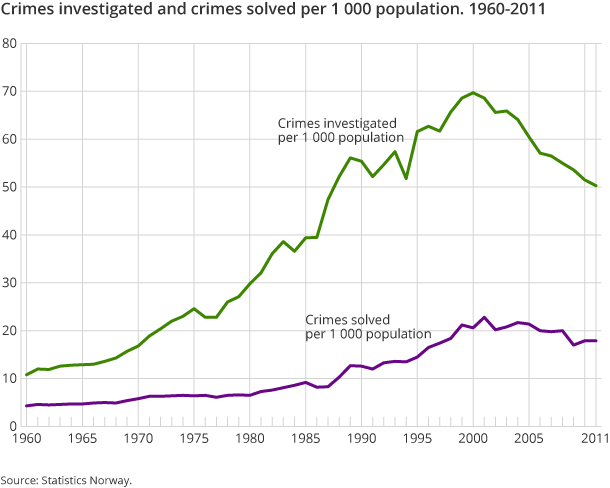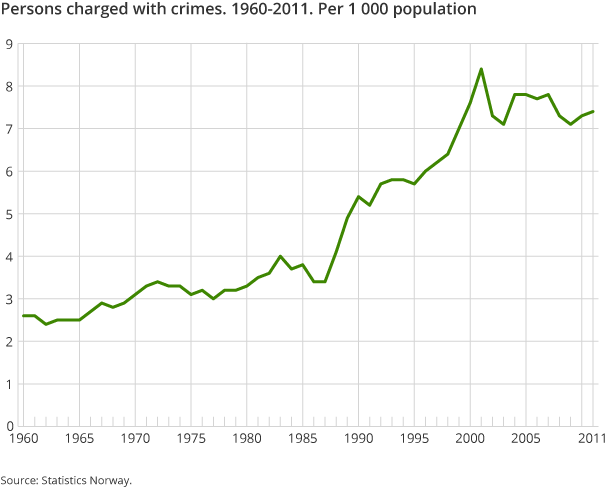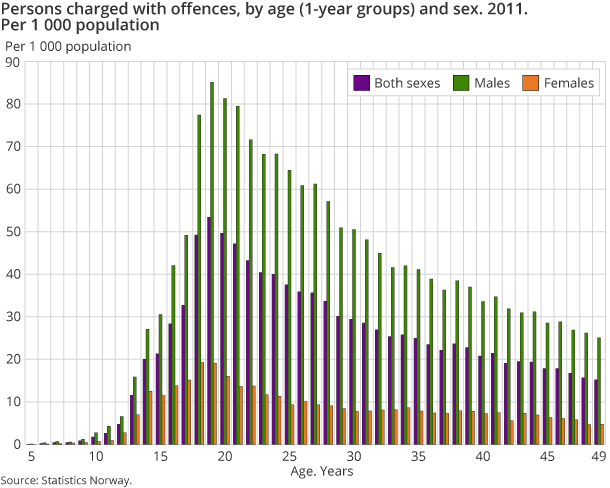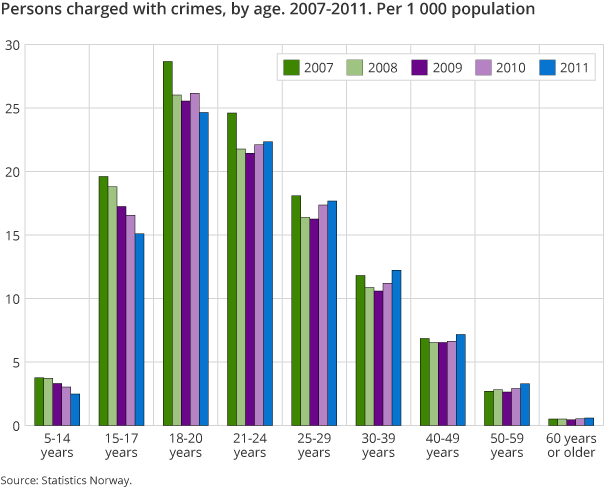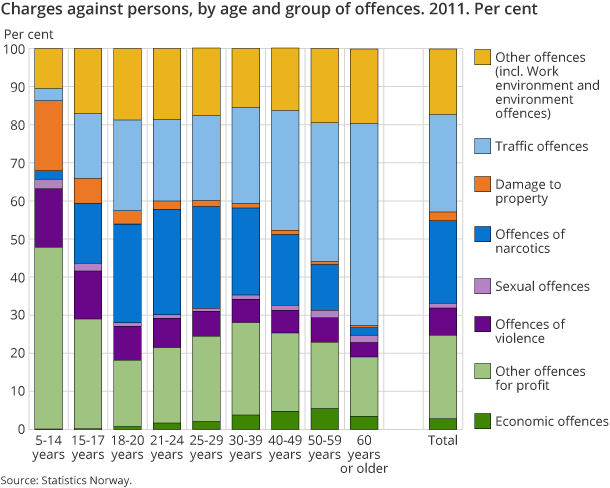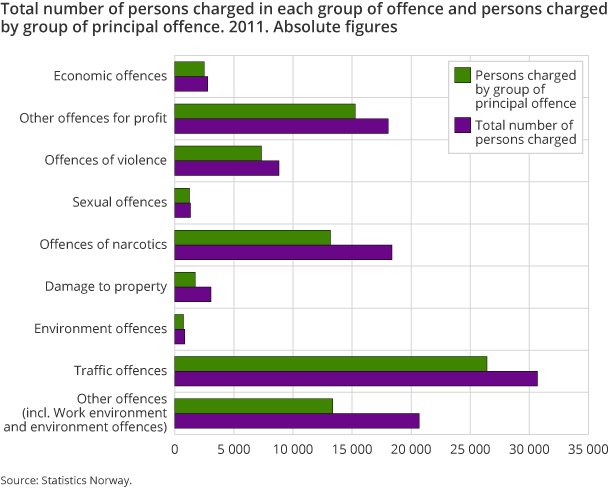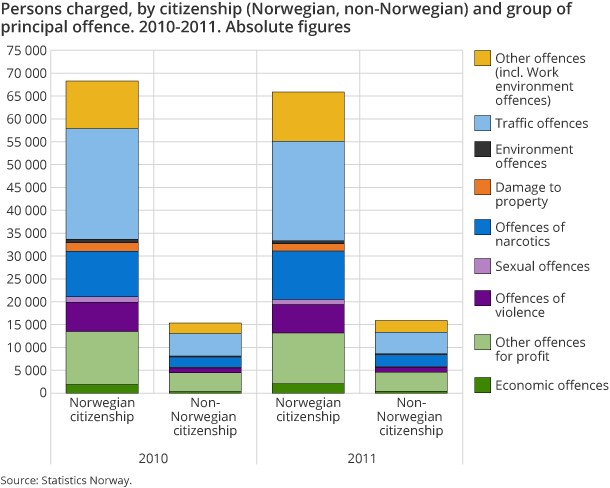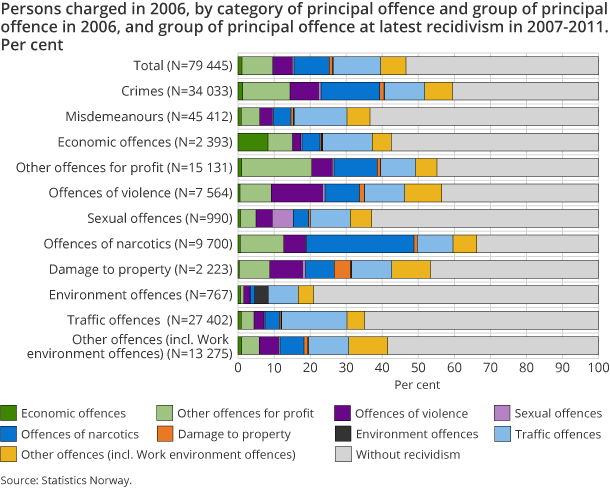Content
Published:
This is an archived release.
More charged with crimes, but fewer youths
The police and the prosecution authority completed the investigation of 363 000 offences in 2011. Of these, 251 000 were crimes and close to 112 000 were misdemeanours, which is 1.8 per cent fewer offences than the previous year. A total of 176 000 offences are regarded as solved, which resulted in 180 000 charges against 81 800 persons.
| 2011 | |
|---|---|
| Offences investigated | 363 189 |
| Offences investigated and solved | 176 223 |
| Charges against persons | 180 352 |
| Persons charged | 81 787 |
| Persons charged in base year included in recidivism statistics | 79 445 |
| Persons charged in base year with recidivism in the following five-year period | 36 930 |
The decrease in the number of offences investigated is related to almost 2 400 fewer offences of both damage to property and offences for profit, and close to 4 400 fewer traffic misdemeanours (excluding on-the-spot fines, see Sanctions). The decline in these groups of offences follows the developments over the previous years. Compared to 2009, there was a 19 per cent drop in damage to property and 7 per cent fewer offences for profit. In the period 2008-2011, there was a 14 per cent decrease in the number of traffic offences.
Even though there was a decrease in the total number of offences for profit, including most of the underlying categories, there was a major increase for some types of larcenies. This particularly applies to the category "Other aggravated larceny", with 22 000 offences investigated in 2011, which is 4 500 more than in 2010. Of these, 17 600 were aggravated larceny from a person in a public place, of which 80 per cent took place in Oslo (for more on development and the breakdown on region, see Offences reported to the police).
More offences of narcotics and public order and peace
The increase in the number of offences investigated was greatest in the categories “Other offences” and offences of narcotics, with 1 650 and 1 000 more than in 2010 respectively. The trend from 2010 continued in 2011, and during the period 2009-2011 there was a major increase in the number of less serious violations of the Act relating to medicines etc., the number of misdemeanours against the police and public order and peace.
Fewer solved, and even fewer unsolved, gave a higher percentage of offences solved
Of all offences investigated in 2011, 176 000 are regarded as solved and 187 000 as unsolved. This is 1.2 per cent fewer solved and 2.4 fewer unsolved than in 2010.
Whether an offence is solved or not, and which legally binding decisions are made, vary substantially for the various groups of offences and types of offences. Drug crimes have the highest share, with 88 per cent, while offences for profit and damage to property have the lowest, with 22 and 19 per cent respectively. The difference varies even more among the more specified types of offences. For example, 98 per cent of all incidents of aggravated larceny from a person in a public place was dismissed due to a lack of information on the perpetrator.
The increase in the number of solved drug crimes and minor disorderly conduct, combined with a fall in reports of larcenies and damage to property that are traditionally not solved led to the share of solved offences increasing from 46 per cent in 2009 to 49 per cent in 2011. For crimes, the share solved increased to 36 per cent, which is higher than the last two preceding years (see figure). The decrease in the number of reported traffic offences, which are traditionally solved, combined with an increase in the number of reported and unsolved larceny from a person in a public place, led to a stable percentage of offences solved in 2011 compared to 2010.
More charged with crimes, but fewer for traffic misdemeanours
In 2011, police investigations resulted in over 180 000 charges against 81 800 persons. A total of 37 000 persons were charged with one or more crimes, while the remaining 44 700 were charged solely with misdemeanours.
In absolute numbers, more than 3 per cent were charged with crimes compared to 2010, and 8 per cent more than in 2009. Adjusted for changes in the population, the increase is somewhat smaller and at a lower level than in the period 2004-2007 (see figure). In the previous three years there has been a constant decrease in the number charged with a traffic offence as their principal offence, and in 2011 there were close to 5 500 fewer than in 2008. Compared to the previous year, there is over a 9 per cent decrease in the number charged with this type of principal offence, which led to a 6 per cent decrease in the number charged with misdemeanours in 2011 compared to 2010.
Highest share among young men
As in previous years, the age group 18-20 years is most overrepresented among persons charged with offences. Most charged are 19 years of age, both for total numbers of offences and among those charged for one or more crimes. Men are charged with offences far more often than women, and in 2011, 8.5 per cent of all 19 year-old men were charged with one or more offence (see figure).
Fewer charged under 19 years of age
In the period 2007-2011, a steadily smaller share of the population 19 years or younger was charged with offences, with a decrease in both charged with crimes and charged solely with misdemeanours. For all age groups 20 years or older, the share charged with crimes increased during the period 2009-2011 (see figure).
The steadily smaller share of charged persons under 18 years is a trend that has continued from the preceding years. For example, those under 18 years of age made up 35 per cent of persons charged with crimes in 1980, while the corresponding share was just 12 per cent in 2011. Various underlying changes have contributed to this development, and the group of offences those under 18 years of age have been charged with has correspondingly changed during recent decades (see Living conditions among youth).
Fewer charged with other offences for profit and violent offences
Almost 18 100 persons were charged with one or more offences for profit in 2011.Over 15 per cent of these were also charged with other offences that have a higher sentencing framework and are classed under another principal offence group. In other words, close to 15 300 persons had one case of larceny or another type of offence for profit as their principal offence (see figure). This is 3 per cent fewer than in 2010 and close to 18 per cent fewer than in 2004. The breakdown of charged persons into the more detailed types of crimes for profit varies somewhat from year to year, and the reduction between 2010 and 2011 is mostly due to a 7 per cent reduction in the number charged with petty larceny and minor larceny from shops as their principal offence.
In total, close to 8 800 persons had 13 000 charges against them for threats and other violent offences in 2011. Of these, 7 300 had one violent offence as their principal offence, which is close to 2 per cent fewer than the previous year and 6 per cent fewer than in 2007. This means that a violent offence was the principal offence for a fifth of all persons charged with crimes in 2011.
Increasing numbers charged with drug offences
A total of 13 200 persons had offences of narcotics as their principal offence in 2011, which is considerably higher than in all previous years for which statistics are available. This is 8 per cent more than in 2010 and 23 per cent more than in 2009. The increase, and the historical high numbers, relates to persons charged with violations of the Penal Code and persons charged with violations of the Act relating to medicines etc. From 2009 until 2011, the increase in the number of persons charged was greatest among those with less serious violations of the Act relating to medicines etc. as their principal offence, with 38 per cent. Those charged with offences of narcotics as their principal offence made up close to 36 per cent of all persons charged with crimes.
A total of 18 400 persons had one or more charges against them for offences of narcotics, and these had a total of 39 100 charges for offences of narcotics during 2011. The charges with offences of narcotics made up close to 22 per cent of all charges with offences, and 41 per cent of all charges with crimes (see figure). Those charged with offences of narcotics made up close to half of all persons charged with crimes, and in the age group 25-29 years they made up 62 per cent.
Changes for Norwegian and foreign citizens
Compared to 2010, there were fewer Norwegian citizens and foreign citizens among those charged with traffic offences. However, there was an increase in the number of persons charged with crimes in both groups; 460 more with Norwegian citizenship and 700 more with foreign citizenship respectively. Foreign citizens made up 19 per cent of all persons charged with crimes in 2011.
Of those charged in 2011 with offences of narcotics as their principal offence, close to 81 per cent had Norwegian citizenship, which is almost the same share as the preceding two years. The increase in the number charged with offences of narcotics is mostly due to an increase among Norwegian citizens with offences of narcotics as their principal offence; almost 700 more than in 2010, but there were also 300 more persons with a foreign citizenship charged with offences of narcotics as their principal offence (see figure).
In general, there has been a considerable increase in the number of persons with foreign citizenship charged during the preceding years, but the increase is less than the general increase of foreign nationals in the population (see Population statistics). In addition to the Norwegian citizens and the foreign citizens resident in Norway, others stay in Norway for shorter or longer periods of time. The number of charged persons who are registered as a resident of another country is, however, higher than in previous years, and made up 7.5 per cent of all persons charged with crimes in 2011.
Highest recidivism among young men
The statistics on recidivism among residents of Norway indicate that 46.5 per cent of the 79 500 persons charged in 2006 were charged once or more during the subsequent five-year period. This share has decreased continuously during the last four recidivism surveys, and was 49.6 per cent for those charged in 2002.
Classified by offence group, the highest rate of recidivism, with 66 per cent, is among those charged with drug crimes as their principal offence. The corresponding share among those charged with violent offences was close to 57 per cent and 55 per cent among those charged with offences for profit. Of all persons charged with sexual offences as their principal offence in 2006, 37 per cent were charged once or more during the period 2007-2011 (see figure).
Almost half of all men charged in 2006 were also charged during the subsequent five-year period, and in the age group 15-17 years, two out of three were repeat offenders. As in previous years, the share of repeat offenders fell substantially with age among men. Around one in every three women were repeat offenders, and the difference between the various age groups is much less pronounced among the women than the men. However, among women, the highest share of repeat offenders is not among the youngest, but among those in the age group 25-29 years, with 37 per cent.
New statistics and time series in StatBank Open and readClose
As from 2010, statistics will be published with the unit charges against persons, in addition to the two other principal units offences and charged persons, which are already included in the statistics. The statistics on charges contain a complete overview of all the offences that the charged persons are charged with during the course of the year.
In relation to earlier publications, some individual tables are supplemented with a large sample of charged persons and several classifications of values for distribution variables. The extended statistics on investigated offences, with time series from the last break in the statistics, can now be extracted as tables from StatBank.
Contact
-
Reid Jone Stene
E-mail: reid.jone.stene@ssb.no
tel.: (+47) 99 02 22 01
-
Siri Fjærtoft Fossanger
E-mail: siri.fossanger@ssb.no
tel.: (+47) 99 72 49 27
-
Sigmund Book Mohn
E-mail: sigmund.mohn@ssb.no
tel.: (+47) 94 32 77 22

